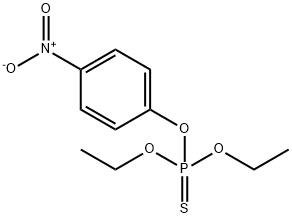56-38-2

Product Name:
Parathion
Formula:
C10H14NO5PS
Synonyms:
O,O-Diethyl O-(4-nitrophenyl) phosphorothioate;Ethylparathione;Parathion-ethyl;Parathion-ethyl solution
Inquiry
CHEMICAL AND PHYSICAL PROPERTIES
| Physical Description | Parathion is a deep brown to yellow liquid with a faint odor of garlic. It is an organic phosphate insecticide which acts as an inhibitor of cholinesterase, and as such it is highly toxic by all routes of exposure. It may be found as a liquid or as a dry mixture where the liquid is absorbed onto a dry carrier. |
|---|---|
| Color/Form | The pure material is a yellowish liquid at temperatures above 6 °C |
| Odor | Usually has a faint odor |
| Boiling Point | 707 °F at 760 mmHg (EPA, 1998) |
| Melting Point | 43 °F (EPA, 1998) |
| Flash Point | 248 to 320 °F (EPA, 1998) |
| Solubility | less than 1 mg/mL at 73 °F (NTP, 1992) |
| Density | 1.26 (EPA, 1998) - Denser than water; will sink |
| Vapor Pressure | 3.78e-05 mmHg at 68 °F (EPA, 1998) |
| LogP | Log Kow= 3.83 |
| Henry's Law Constant | Henry's Law constant = 0.0302 Pa/cu m mole |
| Stability/Shelf Life | STABLE IN DISTILLED WATER IN ACID SOLN; HYDROLYZED IN PRESENCE OF ALKALINE MATERIAL & SLOWLY DECOMP IN AIR. |
| Decomposition | Toxic gases and vapors (such as carbon monoxide, oxides of nitrogen, phosphorus, and sulfur) may be released when parathion ... /undergoes decomposition/. |
| Viscosity | 15.30 CENTIPOISE AT 25 °C |
| Heat of Combustion | -9,240 BTU/LB= -5,140 CAL/G= -215X10+5 J/KG |
| Surface Tension | 39.2 DYNES/CM AT 25 °C |
| Ionization Efficiency | Positive |
| Odor Threshold | 4.00X10-2 ppm (detection in water; purity not specified) |
| Refractive Index | INDEX OF REFRACTION: 1.5370 AT 25 °C/D |
| Collision Cross Section | 158.85 Ų [M+H]+ |
| Kovats Retention Index | 1962 1956 1971 1961 1989 1946 1947 1935 1969 1948.4 1960.4 1967.4 1953.7 1962.9 1951.3 1962.3 1951.2 1940 1950 1935 1941 1941 1942 1989 1953 1952.2 1975 1975 1953 1942 1966.1 1952.9 1992.3 1956.9 1968 |
| Other Experimental Properties | TECHNICAL PRODUCT IS A BROWN LIQUID WITH A GARLIC-LIKE ODOR. /TECHNICAL PRODUCT/ |
| Chemical Classes | Pesticides -> Organophosphate Insecticides |
SAFETY INFORMATION
| Signal word | Danger |
|---|---|
| Pictogram(s) |
 Skull and Crossbones Acute Toxicity GHS06  Health Hazard GHS08  Environment GHS09 |
| GHS Hazard Statements |
H372:Specific target organ toxicity, repeated exposure H410:Hazardous to the aquatic environment, long-term hazard |
| Precautionary Statement Codes |
P262:Do not get in eyes, on skin, or on clothing. P273:Avoid release to the environment. P280:Wear protective gloves/protective clothing/eye protection/face protection. P314:Get medical advice/attention if you feel unwell. |
COMPUTED DESCRIPTORS
| Molecular Weight | 291.26 g/mol |
|---|---|
| XLogP3 | 3.8 |
| Hydrogen Bond Donor Count | 0 |
| Hydrogen Bond Acceptor Count | 6 |
| Rotatable Bond Count | 6 |
| Exact Mass | 291.03303072 g/mol |
| Monoisotopic Mass | 291.03303072 g/mol |
| Topological Polar Surface Area | 106 Ų |
| Heavy Atom Count | 18 |
| Formal Charge | 0 |
| Complexity | 304 |
| Isotope Atom Count | 0 |
| Defined Atom Stereocenter Count | 0 |
| Undefined Atom Stereocenter Count | 0 |
| Defined Bond Stereocenter Count | 0 |
| Undefined Bond Stereocenter Count | 0 |
| Covalently-Bonded Unit Count | 1 |
| Compound Is Canonicalized | Yes |
PRODUCT INTRODUCTION
description
parathion is a yellow-to-brown liquid with an odor of garlic. It is often dissolved in a hydrocarbon solvent before use. Parathion itself is not volatile. It is almost insoluble in water, slightly soluble in petroleum oils, and miscible with many organic solvents.
